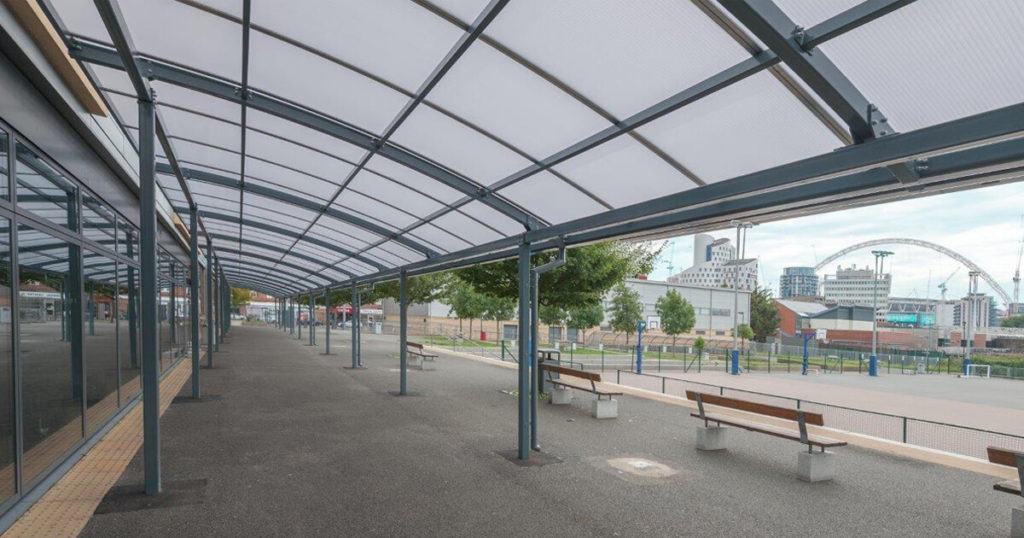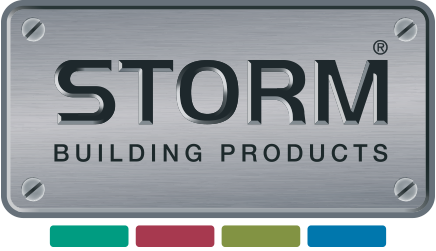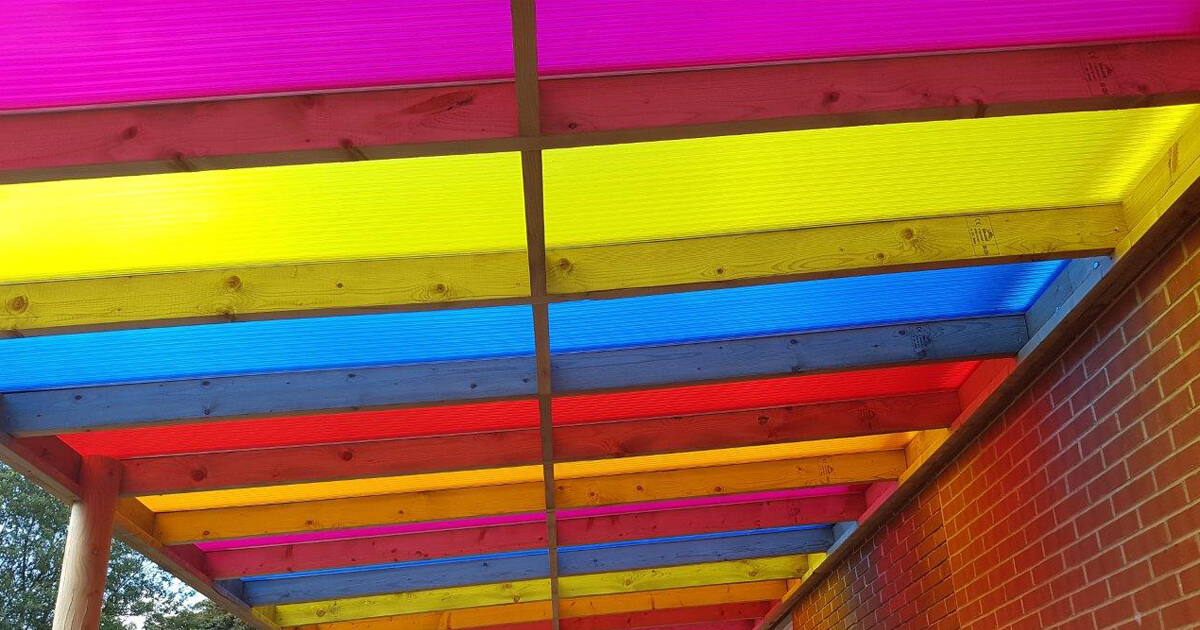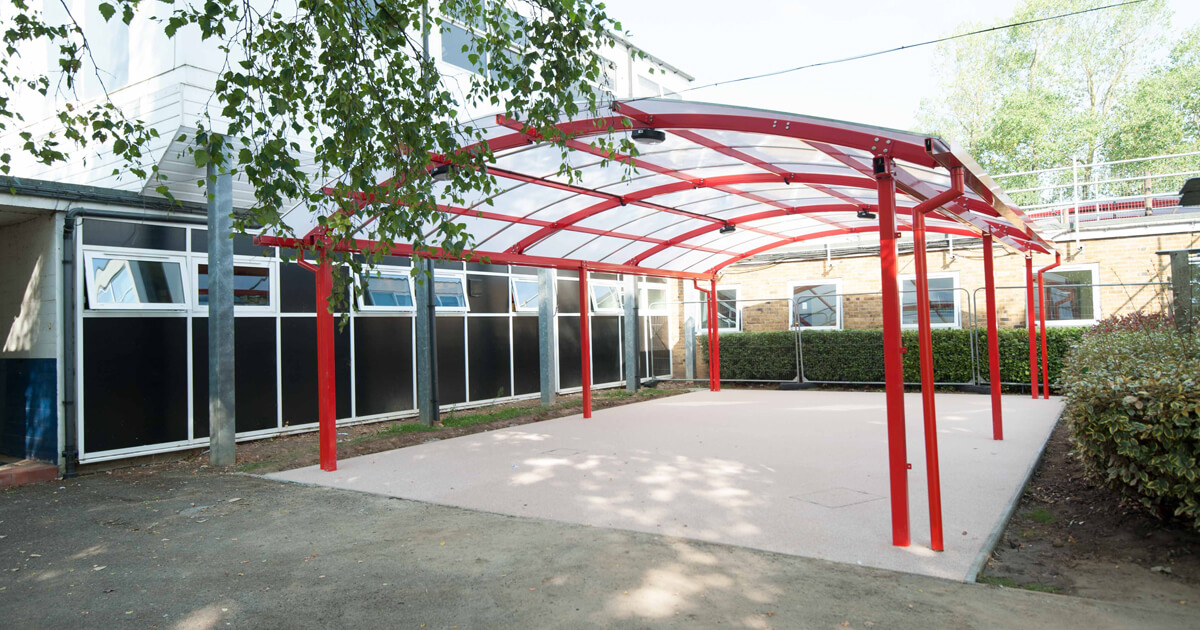
With that in mind, we’ve assembled this comprehensive guide to explain all aspects of how to fit polycarbonate sheeting including:
- What to consider before installation
- Where to store it
- How to install polycarbonate roofing
- How can I ensure that I have installed it correctly?
- Where to get polycarbonate sheeting
What you should know before installing polycarbonate sheeting
Polycarbonate’s impact resistance is 250 times greater than that of glass, making it virtually indestructible. It’s also half the weight, making it far easier to install. It maintains rigidity at high temperatures, is available in UV resistant and fire resistant grades, and is fully recyclable.
Consider polycarbonate’s strengths and benefits to determine if it meets your project’s requirements, compared to other materials.
Depending on the intended use, you may wish to consider what colour polycarbonate sheeting you select. It’s a common misconception that polycarbonate is always clear, however, that is not true.
You can dye polycarbonate sheeting in most colours. See the image below for an example of our FORCE polycarbonate sheeting in several colours for a school canopy.
If you’re unsure about polycarbonate, read our guide on everything you need to know about polycarbonate sheets. Alternatively, call us on 01278 455326 or email [email protected].
Polycarbonate roofs possess strength, lightness, UV ray protection, and the ability to be cut into any shape for perfect installation.
However, we haven’t mentioned that twin and multi-wall polycarbonate offers some insulation too, which helps keep spaces warmer in the winter and cooler in the summer.
Multi-wall polycarbonate has three or more layers, and twin-wall polycarbonate has two layers. The more layers a polycarbonate sheet has, the more insulation it provides.
Storage of polycarbonate sheeting
If you’ve purchased polycarbonate sheeting already make sure it’s stored in a dry place to keep moisture from entering the flutes in the polycarbonate.
Polycarbonate sheeting can be vulnerable to scratching, so this should be taken into consideration when storing and handling.
How to install polycarbonate roofing
To install polycarbonate roofing sheets, choose between twin-wall or multi-wall types of polycarbonate sheeting.
The best way to remember it is, the more layers it has, the more insulation it will provide, therefore the thicker the sheeting is, the more insulation it will provide. For example, 35mm multi-wall polycarbonate is going to provide considerably better insulation than 10mm twin-wall polycarbonate.
This will give you an idea of what thicknesses you will need:
- 4-6mm – greenhouses, sheds and cold frames.
- 10-16mm – lean-to canopies, commercial greenhouses and carports.
- 25mm and 35mm – conservatory roofs.
You will also need a glazing system. Glazing bars are screwed along the centre of the joists, and the polycarbonate sheet is cut to fit between them and laid into place.
You should always make sure that the glazing system has room to compensate for expansion because polycarbonate sheets will change size depending on the temperature.
If it gets warmer the polycarbonate will expand and if it gets colder the polycarbonate will contract.
Whilst polycarbonate is very strong and durable it can be easily cut to shape using a jigsaw, or circular saw that is fitted with fine-toothed blades.
To cut polycarbonate sheeting, ensure the panel is secure so that it doesn’t move, mark the required size on the cover film and cut the panel with the film still on the panel. Once cut you will need to clean away any dust with an air compressor or a vacuum.
If you decide to use polycarbonate for roofing or canopies you should consider the direction of the ribs of the polycarbonate when cutting and before installing.
This is to make sure that the ribs are running in the same direction with the pitch, which ensures consistency. They should be running in the direction of the slope.
Using the right sealant is very important. You should choose a non-hardening sealant, as other sealants could crack, discolour and make your polycarbonate brittle.
You should make sure that the polycarbonate sheets are the right way up! Polycarbonate sheets will only have one side that’s protected from UV, so you will need to make sure that side is facing up towards the sun.
If it’s installed the wrong way up you will not see the benefits of UV protection and this will cause withering and discolouration. The UV protection side is always under the branded film.
When installing polycarbonate roofing, keep a minimum pitch of 5 degrees so that rainwater runs off towards the gutter preventing moisture collecting on your roof.
Once the sheets are in place you can add end caps, remove the protective film, add fixing buttons and add a flash band if required.
How can we ensure the safe and correct installation of polycarbonate sheeting?
To ensure that your polycarbonate sheeting is installed safely and correctly you should make sure that you are using the appropriate safety equipment and are following safe working practices.
Working on a roof can be very dangerous. According to HSE, the accident with the highest number of fatal accidents for workers in 2017/18 was falls from height.
Using the correct PPE and following safe work practices will prevent any injuries. Suitable equipment and PPE should be decided after carrying out a risk assessment and all work at height PPE should comply with the relevant legislation, such as The Work at Height Regulations 2005.
Employers and those in control of any work at height activity must make sure that the work is properly planned, supervised and carried out by competent people. The HSE recommends that you:
- Do as much work as possible from the ground
- Ensure workers can get safely to and from where they work at height
- Ensure equipment is suitable, stable and strong enough for the job, maintained, and checked regularly
- Make sure you don’t overload or overreach when working at height
- Take precautions when working on or near fragile surfaces
- Provide protection from falling objects
- Consider your emergency evacuation and rescue procedures
Who supplies polycarbonate sheeting in the UK?
STORM Building Products supply polycarbonate to distributors throughout the UK. Fill in our ‘find a distributor’ form and we’ll let you know where the closest STORM supplier is.
Our FORCE range of polycarbonate sheeting includes 4mm, 6mm and 10mm twin-wall sheeting and 16mm, 25mm, 32mm and 35mm multiwall sheeting.
Our MISTRAL range includes bitumen, galvanised and PVC corrugated sheeting, and our STRATUS flat polycarbonate sheeting range includes composites and Correx in a choice of thicknesses and sizes.
Want to find your local distributor for polycarbonate installation? Fill in the find a distributor tool on our website or get in touch by emailing [email protected] or calling 01278 455326.
This article was written by Jade Mitchell,
Jade is the Marketing Coordinator at STORM Building Products, she has been working in the building plastics industry since 2016 and has completed ISMM level 2 and 3.



